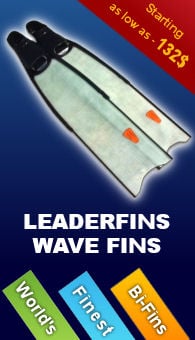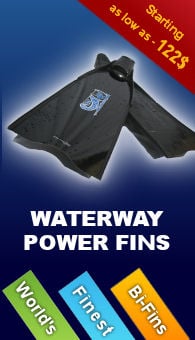Swimming
Swimming makes a very good practice for freediving. A good swimmer can easily be converted into an excellent freediver (assuming he has no pressure equalization issues). Swimming promotes a good aquatic skill (feeling of comfort and wellbeing in water). Swimming helps strengthening and developing the cardiovascular and respiratory systems and trains the musculature in complete absence of gravity which has a considerable advantage to the mobility of joints. A muscle trained through swimming will maintain a long and hydrodynamic form with respect to the same muscle trained during dry activity. Swimming also makes an excellent aerobic exercise. However there should be a distinct sequence of work with different exercises. The following article will present 6 examples of training tables for swimming (as presented in Umberto Pelizarri's book - "Manual Of Freediving - Underwater On A Single Breath") - the times and distances are purely illustrative and should reflect an average swimmer - it is advisable to insert a session of about 20 min of fin swimming at the end of each session to maintain the form of muscles specifically involved in finning. Weight belts can be used to increase the workload.
Table A
200 m warm-up.
(Goals: 80% endurance 20% velocity)
4 * 100 crawl, 10'' rest.
(Goals: 80% endurance 20% velocity)
3 * 200 crawl, arms only, 15'' rest.
(Goals: 80% endurance 20% velocity)
swim 1 length slowly, 1 length quickly;
2 L.S, 2 L.Q; 3 L.S 3 L.Q; 4 L.S 4 L.Q;
3 L.S, 3 L.Q; 2 L.S 2 L.Q; 1 L.S 1 L.Q.
(Goals: 85% endurance 15% velocity)
Table B
200 m warm-up.
4 * 100 crawl, 20'' rest.
3 * 100 crawl, 10'' rest.
2 * 100 crawl, 5'' rest.
(Goals: 80% endurance 20% velocity)
5 * 50, arms only, 15'' rest.
(Goals: 80% endurance 20% velocity)
2 * 150, arms only, 3' rest.
(Goals: 80% endurance 20% velocity)
4 * 50 sprint, 1' rest.
(Goals: 10% endurance 90% velocity)
Table C
200 m warm-up.
2 * 200, 20'' rest.
2 * 100, 15'' rest.
2 * 50, 10'' rest.
(Goals: 80% endurance 20% velocity)
steps: 50, 100, 200, 300, 200, 100, 50 with 1' rest, and at a quick pace.
(Goals: 45% endurance 55% velocity)
300 m arms only, 2 * slowly, 1 * very quickly.
(Goals: 85% endurance 15% velocity)
Table D
200 m warm-up.
3 * 100, 20'' rest.
3 * 75, 15'' rest.
3 * 50, 10'' rest.
(Goals: 80% endurance 20% velocity)
5 * 50, 10'' rest.
(Goals: 75% endurance 25% velocity)
6 * 25, departing every 1', maximum velocity.
(Goals: 10% endurance 90% velocity)
3 * 50 departing every 2', maximum velocity.
(Goals: 10% endurance 90% velocity)
Table E
200 m warm-up.
(Goals: 45% endurance 55% velocity)
4 * 50, departing every 1'30''.
(Goals: 85% endurance 15% velocity)
1 * 400, legs only; 1 * 400, arms only.
(Goals: 100% hypoxic breathing)
2 * 400, 30'' rest, 1 L.S, 1 L.Q.
(Goals: 95% endurance 5% velocity)
Table F
200 m warm-up.
(Goals: 80% endurance 20% velocity)
5 * 75, departing every 1'45''.
(Goals: 80% endurance 20% velocity)
5 * 50, arms only, departing every 1'45''.
(Goals: 100% hypoxic breathing)
1000 m, swimming 100 slow, 100 quick, 200 slow, 200 quick, 100 slow, 100 quick, last 200 at maximum velocity.
(Goals: 72.5% endurance 27.5% velocity)
Wednesday, March 26, 2008
Training - Swimming
Subscribe to:
Post Comments (Atom)








How does table a in section LS and LQ work?
ReplyDeleteL.S = Length slowly
DeleteL.Q = Length quickly
what i mean, what will be the distance of its length?
DeleteThe length is up to you.
DeleteI would start with a 50 or 100m distance and work my way up from there over time.
5 * 75, departing every 1'45''
ReplyDeleteIt means for every 75m stop for a minute and 45 sec and repeat this 5 times, am I right?
Yep, you got it
Delete